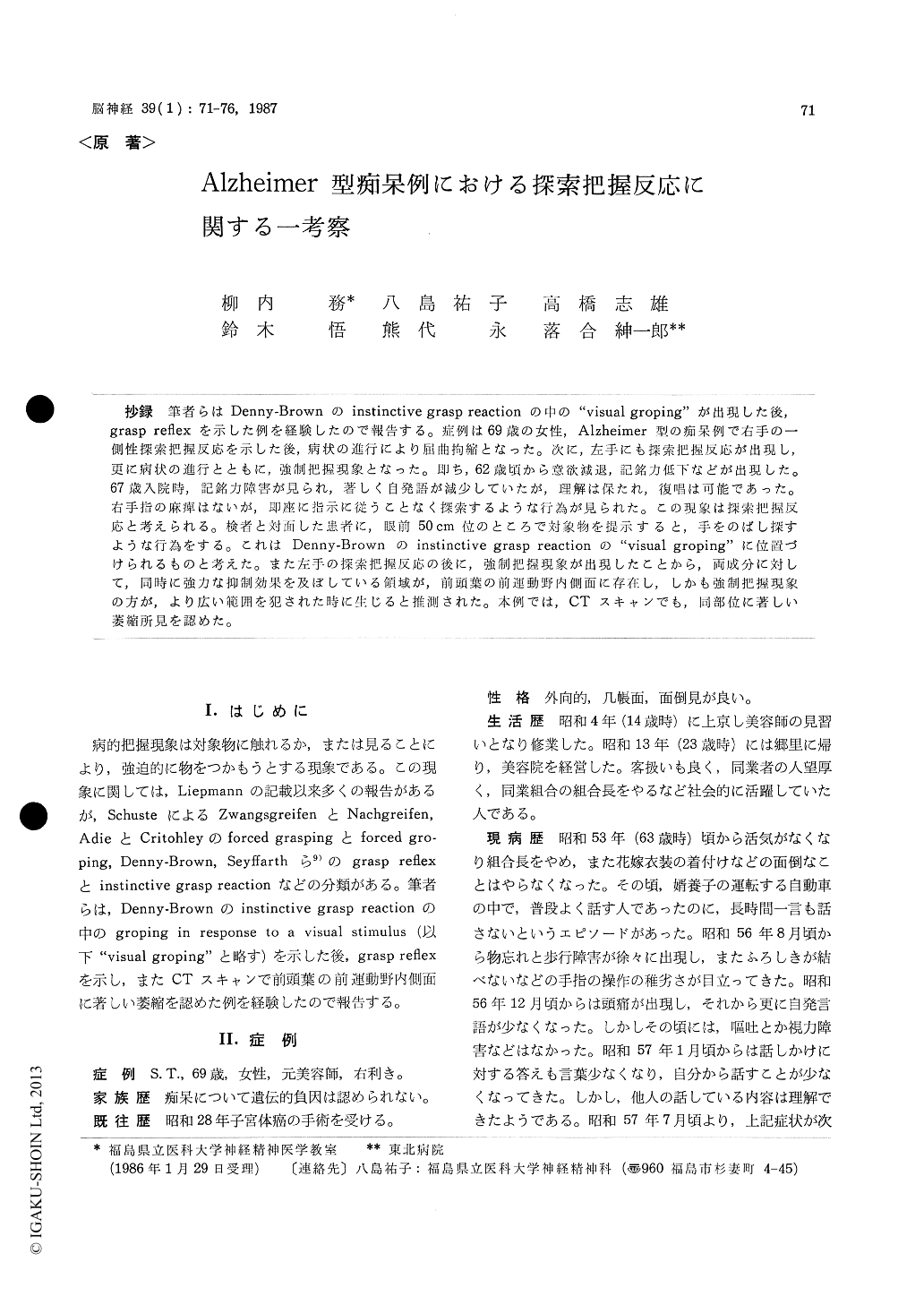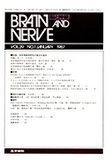Japanese
English
- 有料閲覧
- Abstract 文献概要
- 1ページ目 Look Inside
抄録 筆者らはDenny-Brownのinstinctive grasp reactionの中の"visual groping"が出現した後,grasp reflexを示した例を経験したので報告する。症例は69歳の女性,Alzheimer型の痴呆例で右手の一側性探索把握反応を示した後,病状の進行により屈曲拘縮となった。次に,左手にも探索把握反応が出現し,更に病状の進行とともに,強制把握現象となった。即ち,62歳頃から意欲減退,記銘力低下などが出現した。67歳入院時,記銘力障害が見られ,著しく自発語が減少していたが,理解は保たれ,復唱は可能であった。右手指の麻痺はないが,即座に指示に従うことなく探索するような行為が見られた。この現象は探索把握反応と考えられる。検者と対面した患者に,眼前50cm位のところで対象物を提示すると,手をのばし探すような行為をする。これはDenny-Brownのinstinctive grasp reactionの"visual groping"に位置づけられるものと考えた。また左手の探索把握反応の後に,強制把握現象が出現したことから,両成分に対して,同時に強力な抑制効果を及ぼしている領域が,前頭葉の前運動野内側面に存在し,しかも強制把据現象の方が,より広い範囲を犯された時に生じると推測された。本例では,CTスキャンでも,同部位に著しい萎縮所見を認めた。
We reported a case of senile dementia, Alzhei-mer type, with groping in response to a visual stimulus ("visual groping"). T. S. was a right-handed woman, 69 years old. In the beginning she displayed "visual groping" of the right hand, besides aphasia, lowered registration and Cas-teigne's "Motor neglect" of the right upper extre-mity. As the disease progressed, "visual groping" of the left hand developed, followed by "forced grasping" of the left hand.
When the patient was 62 years old, she first showed decreased volition and lowered registra-tion. Later poor finger movement and lessened speech were marked. At the age of 69, she was admitted to our hospital with aphasia and reduced registration. The patient showed perseveration in naming and drawing tests. She also displayed a "visual groping" phenomenon of the right hand. This phenomenon was reveald when an examiner displayed something about 50 cm in front of the patient, and then she extended the upper extremity gropingly. We considered this phenomonon as "groping in response to a visual stimulus" of Denny-Brown. At the same time, the motor or praxic disorder of this patient consisted of paucity of movement.
When she was told to imitate, her right upper extremity was hardly utilized, although later mo-vements could be realized by her practice. When she was told to pour water from one glass into another, she used her left hand, although she used her right hand for spontaneous actions. So we considered this dyspraxia as a motor neglect of Casteigne.
As the disease progressed, she showed "visual groping" of her left hand, followed by forced grasping of her left hand. This may indicated that there is a strong suppressing area in the inner premotor area. Her brain CT scan showed there was marked atrophy of the inner premotor area of the frontal lobe. In this case, we are interested in three points.
1) First the patient showed "visual groping" of the right hand, followed by the left hand as the disease progressed.
2) After "visual groping" of her left hand sheshowed forced grasping in her left hand.
3) When she showed only "visual groping" of the right hand, she showed hardly any use of her right upper extremity.
From this we concluded that
1) the instinctive grasp reflex is not only due to damage in the non-dominant hemisphere;
2) inner premotor area may strongly suppress both instinctive grasp reflex and grasp reflex, and when the inner premotor area is more damaged, the patient shows a grasp flex after an instinctivegrasp reflex;
3) this dyspraxia was a motor neglect of Cas-teigne.
In this case of Alzheimer type dementia there was atrophy of the frontal lobe with some pheno-mena of frontal lobe syndrome of which "visual groping" is one of them.
The patient's "visual groping", forced grasping and motor neglect were discussed in their relation to the frontal lobe.

Copyright © 1987, Igaku-Shoin Ltd. All rights reserved.


